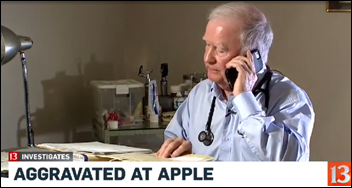Weekender 6/22/18

Weekly News Recap
- CareSync closes without warning amid rumors that the sale of the company fell through
- McKesson is among the rumored potential acquirers of prescription discount coupon site GoodRx, which could fetch up to $3 billion
- Surgeon, professor, and journalist Atul Gawande, MD is named CEO of the new healthcare venture of Amazon, Berkshire Hathaway, and JPMorgan Chase
- House lawmakers will create an oversight subcommittee to monitor the VA’s $10 billion Cerner implementation
- Quest Analytics acquires BetterDoctor
- Verscend will acquire healthcare payments vendor Cotiviti for $4.9 billion
- Walmart patents a system for storing a patient’s vital medical information in blockchain database housed in a wearable device
- A judge rules that MD Anderson Cancer Center (TX) must pay $4.3 million in penalties for HIPAA violations stemming from three data breaches and non-compliance in following up with device encryption
- The US Attorney indicts Theranos founder and CEO Elizabeth Holmes and former President and COO Sunny Balwani for fraud
- IBM Watson Health executives tell employees that the company will scale back its hospital pay-for-performance tools business
Best Reader Comments
A few weeks ago our CEO bought some branded bike jerseys for those of us participating in a fundraiser. The jerseys are pretty sharp looking and fit well so I’ve been wearing mine frequently. It has definitely been in the back of my mind that I’m wearing a billboard and any perceived misbehavior of mine could look bad for the company. (RobLS)
The issue is not them documenting “not taking.” The issue is that the “not taking” doesn’t remain and I have to say I’m not taking the med every at every visit. Can you imagine if you’d been on an EHR for 70+ years and have to now rattle off 100 different medications that you’re not taking since you were born? Still think it’s a good design decision and patient to blame? (AC)
I hear so many complaints about how EHRs are ruining the practice of medicine by requiring doctors click this and that to document that they’ve reviewed medications, acknowledged allergies, etc. and I have to ask: what were you doing before? (HIT Girl)
What diligence process did Walgreens use to vet Theranos? They were actually marketing this stuff to their customers. I have personally been at VC retreats where Walgreens was proudly preening themselves about their Theranos partnership and the VCs were fawning all over them. (Charlie Harris)
It was so clear to me [about suicide] that this was a medical problem as obvious and in need of treatment as much as if he’d had a bad kidneys or heart disease; his brain was not functioning the way it was supposed to. Unfortunately the country he lived in was (and is) notorious for their total failure in the mental health department, and what should have been an emergency inpatient admission with immediate intervention became his wife, his daughters, his sister, and friends doing everything they could to keep him alive until he could be seen by a doctor. He was failed, and his family was failed. (HIT Girl)
Watercooler Talk Tidbits


Readers funded the DonorsChoose grant request of Ms. T in Texas, who asked for a STEM bundle for her kindergarten class. She reports, “Besides sparking creativity in the classroom, the STEM activities help the students dig deeper and use higher order thinking skills to create different things. These items donated have greatly impacted some of our children that have special needs and behavioral issues. For those students with behavioral issues, these items have helped the student stay focused during Center time and shown the teachers those children’s creative side. It has help those special needs students by allowing them to tinker with the items and also keep them engaged during Center time. The teachers in Room 1 greatly appreciate your generosity in donating to our classroom.”

Healthcare billionaire Patrick Soon-Shiong closes his $500 million acquisition of the Lost Angeles Times, San Diego Union-Tribune, and several community newspapers from Tronc. Tronc, the former Tribune Publishing, has also announced that it will revert to its old name following the ongoing ridicule since its 2016 rebranding that attempted to make the company seem more contemporary, a name that major shareholder Soon-Shiong had called “silly.” The Tronc name was advocated by former chairman Michael Ferro, who has since resigned following sexual harassment allegations. He was also chairman of Merge Healthcare, sold to IBM for $1 billion in 2015.

The closure of CareSync is big news considering the company had raised at least $50 million and had announced rosy hiring projections. Here’s a timeline:
- February 2008 – Travis Bond sells his EHR and physician practice services vendor Bond Technologies to MediNotes, which acquired by Eclipsys for $45 million a few months later
- September 2011 – Bond forms CareSync to obtain and manage the medical records of patients
- July 2014 – co-founder Florida State Rep. Jamie Grant is cleared of ethics violations involving his alleged use of $2.5 million of county economic development grants to fund his startup LifeSync Technologies, which created CareSync
- October 2014 – raises $4.25 million
- February 2015 – adds services to help practices collect payments under what would later become CMS’s Chronic Care Management program
- October 2015 – raises $18 million
- January 2016 – joins Athenahealth’s More Disruption Please program
- February 2016 – fills three new VP positions
- December 2016 – moves its office to a 51,000 square foot building in the Tampa area and announces that it will hire 350 employees in the next year, increasing headcount to 500
- January 2017 – fills four new executive positions
- June 2018 – the sale of the company falls through and all employees are ordered to leave the premises immediately, apparently with no severance pay or COBRA insurance option
The New York Post observes that companies are selling their private jets, noting that the announcement by GE and Athenahealth preceded the dismissal of their chief executives.
Intel forces CEO and board chair Brian Krzanich out for violating the company’s non-fraternization policy by having a relationship with another Intel employee.

IBM touts its AI technology by having its Project Debater challenge two experienced debaters, perhaps trying to rekindle interest from its “Jeopardy” glory days as Watson Health has achieved little since. Project Debater argued in favor of telemedicine, saying with humorous intent that it believes in the power of technology, while the human debaters said that telemedicine doesn’t offer the hands-on power of a doctor or nurse.

Reaction to the hiring of Atul Gawande, MD as CEO of the non-profit healthcare project of Amazon, Berkshire Hathaway, and JPMorgan is mixed. Some experts noting his vision, story-telling abilities, and past criticism of the healthcare system, while others question his lack of experience in running a large enterprise and his plans to continue working as chairman of Ariadne Labs, surgeon, and New York Times author. Said one, “It starts to feel fundamentally unserious if you’re not hiring a full-time CEO. If you’re transforming healthcare, you’re reshaping the economy of Germany, effectively. It’s not a part-time gig.”
In Case You Missed It
- News 6/22/18
- EPtalk by Dr. Jayne 6/21/18
- News 6/20/18
- HIStalk Interviews John Talaga, EVP/GM, OnPlan Health
- Curbside Consult with Dr. Jayne 6/18/18
- Monday Morning Update 6/18/18
- What I Wish I’d Known Before … Considering or Attempting Suicide or Losing a Friend, Family Member, or Co-Worker To It
Get Involved
- Join my Rolodex to provide occasional news reaction or ideas
- Contribute regularly as a provider CIO, IT director, or informatics nurse (anonymous or not)
- Be interviewed (providers)
- Deliver an educational webinar (providers)
- Sponsor
- Report a news item or rumor (anonymous or not)
- Sign up for email updates
- Connect on LinkedIn
- Contact Mr. H























































Anything related to defense will need to go to Genesis.